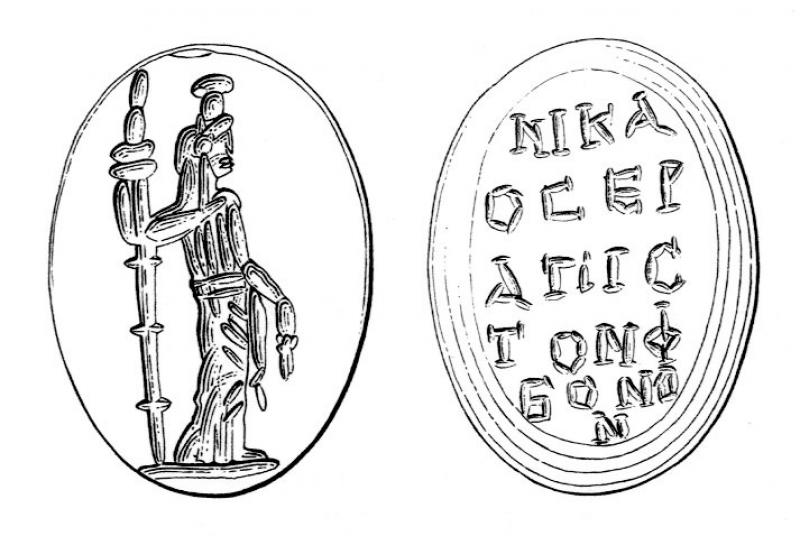Bonner, SMA, 96.
then a formula of which the normal form, known from other specimens, is αιαναγβα αμοραχθι σαλαμαζα βαμεαζα.3 Finally, the word φύλαξον, which begins a prayer continued on the bevel, ἐκ παντὸς δεμονίου Σαβίναν ἣν ἔτεκε Καλπουρνία, “Protect Sabina, daughter of Calpurnia, from every demon.” The reverse has only meaningless combinations of the vowels, with a very few consonants. Some of the letters are upside down, some are written from left to right.
Huebner found in Madrid a small gold lamella which he published with notes by Kirchhoff; it was taken over later into IG XIV, 203, 13. There are four lines, of which the first two and the greater part of the third can be read thus: πᾶν ιερον (l. μιερον for μιαρὸν) πνεῦμα καὶ κακοποιὸν καὶ φθοροποιόν ἀπάλασον (l. ἀπάλλαξον) ἀπὸ τῆς . . .. The following letters must be meant for the name of the wearer, but they are evidently wrongly incised, as no recognizable name can be made from them. The fourth line probably consisted (after the first four letters, λιας, part of the name) of magical words. The form ἀπάλασον, like τάσσον on a stone previously discussed (p. 82), seems to represent a softened pronunciation of ξ;4 or else an aorist imperative ending has been wrongly attached to a present stem. Since the wearer was a woman, it is possible that φθοροποιόν meant not merely destructive, but, specifically, causing miscarriage.
Many amulets inscribed φύλασσε, φύλαξον, διαφύλασσε, etc., were probably intended for defense against demonic enemies. Among unseen dangers the most dreaded was undoubtedly the evil eye, the blighting glance of envy, which is still feared in all the countries bordering on the Mediterranean and has scarcely been forgotten in northern Europe; a special meaning of the word “overlook,” formerly current among ignorant people in England, is a relic of this superstition. The ancient texts and monuments relating to the evil eye were treated by Otto Jahn in a monograph which, after ninety years, is still indispensable, and folklorists and anthropologists have collected evidence of the superstition from many countries.5 Here we are concerned with a few amulets that show how the evil eye was feared, and what means were used to ward off its destructive glance.
A green jasper in the British Museum has on the obverse a goddess standing, facing right, a modius on her head, the right hand holding a tall scepter (or a torch), the left a fold of drapery.6 On the reverse is the inscription νικᾷ ὁ Σέραπις τὸν Φθόνον, “Sarapis overcomes envy.” Here “envy” is
3 The Correr stone has αμοραχει, and other minor variations occur. The formula is inscribed on the reverse of a British Museum gem (56329) and of one in the Cabinet des Médailles (Chabouillet 2206). Neither has any figure design except the ouroboros, which encloses unintelligible signs on the obverse. See, further, Capello, Prodromus Iconicus, Nos. 29, 158, 208, repeated in Montfaucon, II, 2, Pl. 165, 4, 6; Pl. 166, 2.
4 This phenomenon is known in Latin; cf. axis (assis), assula; coxim, cossim (Lindsay, Lat. Lang., p. 102). So far as I know, it has not been observed in Greek words; see, however, AJP 62, 455-457.
5 O. Jahn, “Über den Aberglauben des bösen Blicks bei den Alten,” Ber. sächs. 1855, pp. 28–110; P. Bienkowski, “Malocchio,” Eranos Vindobonensis, 1893, pp. 285–303; F. T. Elworthy, The Evil Eye, London, 1895; S. Seligmann, Der böse Blick and Verwandtes, Berlin, 1910.
6 B. M. 56161; King, Gnostics, Pl. E 4.
Last modified: 2012-11-05 11:08:47
Link: cbd.mfab.hu/pandecta/1536

